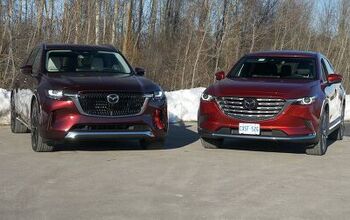Ford Explorer vs Mazda CX-90 Comparison

The more things change…
Back at the turn of the century, Ford and Mazda had a close working relationship. Engines, platforms—and in some cases, basically entire cars—were shared between Dearborn and Hiroshima.
They’ve since gone their separate ways, and yet both brands have ended up with a similar formula for their mid-sized three-row SUVs. After a generation of essentially being a burly Taurus, the Explorer has moved back to a rear-drive-biased platform once again. Mazda’s CX-90 was all-new two years ago, riding on a whole new rear-biased platform as well, with a fresh inline-six engine to boot.
As the only two mainstream offerings with this layout, the Explorer and CX-90 offer buyers a different experience. Which of them does a better job of it? Mike Schlee and I are on the case.
What's New for 2025:
Ford Explorer: The Explorer receives a significant facelift for the new year. There are styling tweaks outside and—especially—in, with the requisite bump in available technology as well. The unloved hybrid model is gone, and while there are no on-paper improvements to the existing 2.3-liter turbo inline-four nor 3.0-liter turbo V6, Ford has updated the 10-speed automatic they come lashed to.
Mazda CX-90: There’s not much change for the CX-90, as it’s only been on the market for two years. Buyers continue to have the choice of the 3.3-liter inline-six in two states of tune—the one here is the 280-horsepower version—as well as a plug-in hybrid, which utilizes Mazda’s naturally-aspirated 2.5-liter four-pot.
Exterior Style:
Explorer: Even though it has a fresh face, the Explorer doesn’t necessarily feel new. Maybe that’s due to it being the ride of choice for law enforcement.”Although the Explorer received an update this year, it’s hard to tell the difference,” notes Schlee, before taking the gloves off. “Compared to the Mazda CX-90, the Explorer looks downright ordinary. Nothing stands out in a style sense. It’s completely anonymous.” Ouch. Stand it beside a ‘24 and the new model is more assertive, with a larger, squared-off grille. Ford’s take on the oh-so-common full-width taillight treatment is pretty cool to these eyes, too.
CX-90: Do you want one of the most handsome three-row shapes on the market, with elegant surfacing and tasteful amounts of chrome? Do you then want to paint it in the most boring color imaginable? Well does this press car ever nail your very specific needs. The CX-90 still looks good, applying Mazda’s handsome design language to a decidedly cab-rearward shape, but this dull gray isn’t helping. We appreciate the non-black wheels, but even that design fails to stand out.
Powertrain and Fuel Economy:
Explorer: This tester is the ST-Line, which borrows the styling bits of the sporty ST but sticks to the base 2.3-liter turbo-four. Some may baulk at the idea of so few cylinders tasked with hauling around so much Ford, but this is the same engine found in a Mustang, remember? 300 horsepower is nothing to sneeze at. The Explorer ably gets up to highway speeds, and it does so with a surprise considering the noise we experienced in the last EcoBoost Mustang we drove.
“In Sport mode the Explorer makes some pleasing sounds,” notes Mike. “Sure it’s being fed through the speakers to a degree, but I don’t care. What I hear is nice.”
Neither of us thought we’d be praising Ford’s 10-speed automatic transmission, but here we are. The Blue Oval has done its homework, transforming a frustrating ‘box into a solid partner for the four-pot. There’s little of the gear-hunting of old, and responses off the line give the impression the Explorer is actually the quicker vehicle.
One area the Explorer lags is fuel economy. Officially it will achieve 20 mpg city and 27 mpg highway, for a 23 mpg combined figure. Canadian equivalents are 11.9, 8.7, and 10.3 L/100 km, respectively. We saw figures roughly in-line with this.
CX-90: Initially, the low-power version of the CX-90’s engine fails to impress. Sure, it’s plenty torquey, but there’s not much of that creamy sound that makes this the cylinder arrangement of choice for luxury brands.
The roadblock is the new eight-speed auto that Mazda has built for this platform. When tasked with daily duties it’s indecisive and slow, hopping between gears but never seemingly satisfied with any. Driven with verve it’s a very responsive ‘box, but let’s be realistic: you aren’t going to be caning your big family hauler on the regular. The eight-speed is what keeps the Mazda from feeling quite so spritely off the line, though once on the move it’s got the Ford.
It certainly beats the Explorer on fuel economy too, and thankfully both vehicles use regular fuel. The Mazda’s official figures are 23 mpg city, 28 mpg highway, and 25 mpg combined. The Canadian figures? 9.9, 8.4, and 9.3 L/100 km, respectively. During the week, the Mazda handily improved on those stats, too.
Handling and Drivability:
Explorer: Now don’t go thinking that because this is a rear-biased SUV from the folks who’ve had the best-selling truck for half a century, that it drives like a truck. Ford has tuned the Explorer’s suspension in such a way that—for better or worse—it drives pretty much like any of the front-biased offerings in the segment.
That’s not a bad thing. The Explorer is easy to maneuver, goes and stops where it’s asked and, even in this ST-Line trim, remains cushy and comfortable. In fact, those expecting an ST experience only with less power may be disappointed. The Explorer is not sporty, nor interested in the sorts of twisty bits of tarmac that wake up the CX-90.
The brakes, which were a source of criticism in the last Explorer we drove, are progressive and predictable.
CX-90: The Mazda shares that easy-to-drive feel found in the Explorer. Neither is a small vehicle, but always feel positive and confident even in tight city streets.
Send the CX-90 out on the hunt for squigglier bits of the map and it repays the dedication with real weight to its right-sized steering wheel. Like the Ford, there’s not a whole lot of signals that this is a rear-biased setup, as neither axle dominates the experience. There’s still that Mazda crispness on turn-in, thankfully. Braking is strong, too.
Ride Quality and Comfort:
Explorer: The Explorer isn’t particularly sporty, so it should be a comfortable ride, right?
It’s not uncomfortable, but the Explorer is hardly an example for the breed. The big Blue Oval ‘ute just blends in, offering a ride that is pure middle of the road. There’s good noise insulation and the suspension soaks up bumps well enough, but there's nothing here to set it out from the rest of the three-row pack.
“Although Kyle much prefers the front seats in the CX-90,” says Schlee, “I like the ones in the Explorer nearly as much. If it wasn’t for the abrasive inset material, the Explorer front seats would
be really good.”
The Explorer is the more spacious choice for second- and third-row passengers. Not by much, but a win is a win.
CX-90: Mike made the comment that getting into the CX-90 is like switching to flat tires, which seems unfair… but I get where he’s coming from. There’s no way around it: the Mazda rides firm. That’s easier to justify in something like a Mazda3 than a three-row SUV, especially when the latter might be stuffed full of kids, grandparents, and all their assorted paraphernalia. The CX-90 settles quite nicely on the highway, where body control is excellent, but the inner-city ride is simply jiggly.
I do vastly prefer the CX-90’s seats, yes. They’re well-shaped, very supportive, and come in a material that doesn’t put me on edge.
Interior Style and Quality:
Explorer: Ford made a concerted effort to improve the Explorer’s cabin ambiance after the cheap-feeling 2020 model. Largely, it has succeeded: while it doesn’t reset the bar for the segment, the ST-Line makes good use of textures and red stitching throughout the cabin to liven things up. There are still brittle, shiny plastics, but they’re now relegated to out-of-the-way spots.
There’s no arguing that it’s the more practical of the two as well, with ample storage cubbies and the clever two-level center console.
CX-90: No doubt about it, the CX-90 is the nicer space to spend time in. Mazda has been at this game for around a decade now: building cabins that truly do straddle the line between mainstream and premium. The soft-touch dashboard has an organic shape, peeling back to make space for the infotainment screen. There are bits of chrome, but only as accents. While nobody is likely to ever admit it, it’s clear Mazda targeted previous-generation BMWs in the way it has logically grouped all the actual physical buttons together. The only obvious plastic bits are the window switch and shifter surrounds.
The trade-off to all this style is a cabin that is only okay at storage. The central cubby is reasonably capacious but can’t hold a candle to the Ford’s dual-level setup.
Tech and Safety:
Explorer: “Blue Cruise. That’s all I have to say,” Schlee explains, before then adding: “systems like these completely transform family road trip vehicles like the Explorer.”
He’s right though. Blue Cruise is such a helpful addition that it’s one of the Explorer’s strongest arguments. Not that the rest of the driver assist suite is lacking, because it isn’t: with the ‘25 freshening up, every trim now features blind-spot monitoring with rear cross-traffic alert, in addition to the expected automated emergency braking and lane-keep assist.
Ford’s infotainment system is also miles ahead of Mazda’s: big, bright, and easy to use.
CX-90: We’re just as tired of complaining about Mazda’s infotainment as you likely are of hearing it. The tricky sometimes-touchscreen capability, the sub-sub-menu diving; it’s just not satisfying to use. Where the Ford has a sharp digital instrument cluster, the Mazda has a mixed display that barely makes use of its digital aspect.
The Mazda’s safety suite does most everything the Ford does, but it lacks a true competitor for Blue Cruise. At least the CX-90 gets… front cross-traffic alert, so you can enjoy a chorus of beeping at every intersection.
Value Dollars and Sense:
Explorer: In America, the Explorer ST-Line lists for $46,210 including destination. Adding AWD tacks on another two grand, and this tester’s options list pegs it at $53,250.
In Canada, where AWD is standard, the Explorer ST-Line starts at $58,730 CAD including destination. Adding the options here bring it to $64,830 CAD.
CX-90: There isn’t an exact American-equivalent for our Canuck-spec tester. It’s more or less the CX-90 3.3 Turbo Premium Plus ($50,855 including destination), with premium paint (an additional $595. That model comes with upgraded Nappa leather seating however, and is only available with second-row captain’s chairs.
Canadian pricing is strong: the CX-90 Turbo GT lists for $57,545 CAD, and the gray paint is an additional $400 CAD. That puts it comfortably under the Explorer.
Final Thoughts: Ford Explorer vs Mazda CX-90 Comparison
If a pure family workhorse is what you’re after, the Explorer is the better bet. What it lacks in cabin ambience, it makes up for with sheer space and practicality. The big Ford also has the Mazda licked on infotainment and driver assist tech, especially BlueCruise. It’s pricey for what it is, but the Explorer is still plenty capable for family duties.
Given that price advantage—either a little or a lot, depending on country—it’s hard not to give the nod to the Mazda CX-90, however. It’s a classier, more grown-up proposition, one that is still satisfying to drive and surprisingly economical. If Mazda can smooth out the transmission and suspension, it could genuinely surprise the luxury establishment.
Category | Ford Explorer | Mazda CX-90 |
Powertrain | 7 / 10 | 8 / 10 |
Efficiency | 7 / 10 | 9 / 10 |
Handling and Drivability | 7 / 10 | 8 / 10 |
Passenger Comfort | 7 / 10 | 7 / 10 |
Ride Quality | 4 / 5 | 3 / 5 |
Exterior Style | 3 / 5 | 4 / 5 |
Interior Style and Quality | 7 / 10 | 8 / 10 |
Infotainment | 8 / 10 | 6 / 10 |
Cargo Capacity and Towing | 5 / 5 | 4 / 5 |
Safety | 5 / 5 | 4 / 5 |
Value | 7 / 10 | 8 / 10 |
Emotional Appeal | 7 / 10 | 8 / 10 |
TOTAL | 74 / 100 | 77 / 100 |
Specifications | Ford Explorer | Mazda CX-90 |
Engine: | 2.3L I4 Turbo | 3.3L I6 Turbo |
Outputs: | 300 hp, 310 lb-ft | 280 hp, 332 lb-ft |
Drivetrain: | AWD | AWD |
Transmission: | 10AT | 8AT |
US Fuel Economy (mpg): | 20/27/23 | 23/28/25 |
CAN Fuel Economy (L/100 km): | 11.9/8.7/10.4 | 9.9/8.4/9.3 |
Starting Price (USD): | $41,350 (inc. dest.) | $39,300 (inc. dest.) |
As-Tested (USD): | $53,250 (inc. est.) | See text |
Starting Price (CAD): | $52,730 (inc. dest.) | $48,095 (inc. dest.) |
As-Tested Price (CAD): | $64,830 (inc. dest.) | $57,945 (inc. dest.) |

Kyle began his automotive obsession before he even started school, courtesy of a remote control Porsche and various LEGO sets. He later studied advertising and graphic design at Humber College, which led him to writing about cars (both real and digital). He is now a proud member of the Automobile Journalists Association of Canada (AJAC), where he was the Journalist of the Year runner-up for 2021.
More by Kyle Patrick


















































Comments
Join the conversation
What is the best buy in this segment under $48k with a 6 cylinder motor?
Hmmmm,,,, So the Ford has a smaller engine and two more gears but gets worse gas mileage then the Mazda??!! Somehow I'm not surprised, you're running a 2.3 that I had in a Pinto to push around twice the weight. I will bet it does not stand up as well as Mazda's six either.
I like the look of the Ford better ( I find it's the Mazda that looks boring) but having had quite a few straight six's over the years ( Gremlin, TVR, TR6, Ford Van, Jeep TJ) and that would seal the deal for me to buy the Mazda.